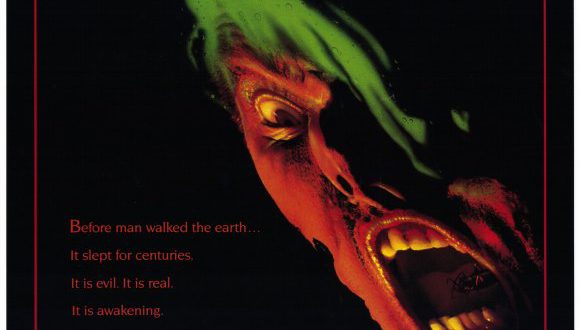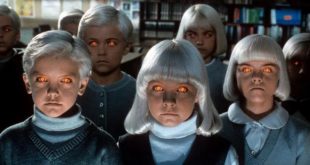What would a former Catholic Church basement, theoretical physics, a swirling green liquid, Alice Cooper and Satan all have in common? Why, Prince of Darkness, of course!
Warning: This trailer itself contains a spoiler!
https://www.youtube.com/watch?v=PKI2kI6Flw0
Welcome to the world of Prince of Darkness, where all your dreams come true — provided they’re alternately cryptic, apocalyptic, creepy and zany. Personally, I don’t remember precisely when I first saw Prince of Darkness, but it made an impression. While I was never the type to be afraid of monsters (not really anyway), I do remember some key scenes from this one solidly creeping me out.
Watching it now I can say, quite frankly, it’s a bit of a messy movie, even aside from the gore. Nevertheless, the central idea is freaky, and these crazy elements work for two reasons: (1) A skilled director, and (2) actors who know how to make a strange movie almost believable. While none of the cast won an Oscar (and most critics panned the film), their portrayals are all up to par and help carry the story.
Why Critics Didn’t Like It

Obviously, a major aspect of Prince of Darkness is the concept of Satan, and how evil is transferable through countless forms — worms, insects, data, equations, homeless people, you name it. It’s a mind boggling proposition for sure, and the “matter of fact” treatment Carpenter gives it could throw people off. Still, any sensible person would suspend disbelief and just watch the madness unfold. I believe most critics didn’t do that, or they looked at some minor flaws and blew them out of proportion — standard critic stuff. Personally, I almost regard it as a classic — or, if you feel that word’s overused, I’ll just say I like it.
How The Concepts Work

Like many horror classics, this one relies on feelings of increasing paranoia and “otherness.” The big question becomes, are the characters safer inside or outside the building? That’s because, as day turns into night, everything seems to veer closer to, well, darkness. This is one of the oldest concepts in horror. How does John Carpenter keep it relatively fresh? Partly through sheer force of will on part of the viewer. Basically, you are either with this film or against it. It seems Carpenter trusts the viewer to understand things that are difficult — if not impossible — to grasp. In that sense, I’m tempted to say he respects them.
Sure, certain characters are either killed, possessed, possessed then killed, or killed and then possessed, but that alone is not the horror. The idea of “anti-matter” blending with the “anti-God” is supposed to send shivers down your spine. However, if it doesn’t — and even if you don’t know what the hell anti-matter is — you can surely still enjoy the results of such a unique story. Who knows? You may never look at worms, mirrors and bugs the same way again.
The Performances

Finally, I should mention the actors. Donald Pleasance does a great job as the Priest whose performance is perhaps only outshined by Victor Wong as the Professor. Dennis Dun is loveable (and occasionally annoying) as Walter. Alice Cooper makes an appearance as an evil, schizoid bum… because why not? On that note, let me mention that Alice’s rock star power doesn’t overpower the other performances.
For example, who can forget about Jessie Lawrence Ferguson as Calder? His crazed laughter majorly adds to the tension of various scenes, while retaining a vague aspect of humor. Also, there’s some lasting power in the grotesque transformation of Susan Blanchard’s character, Kelly, who could potentially give one nightmares (thanks in part to the freaky makeup effects, too).
Then you have Jameson Parker as Brian Marsh. Though Parker’s performance is understated (and therefore inevitably overlooked), it lends him the appearance of an everyman — albeit an intelligent everyman, given his character’s profession. Also, the final scene actually features Parker with his hand reaching out — perhaps into the unknown, perhaps not. That was a clever idea, and Parker didn’t botch the scene. Also, I doubt Simon & Simon could be his everything.
 PopHorror Let's Get Scared
PopHorror Let's Get Scared




